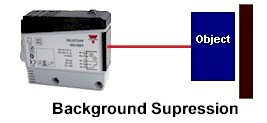 |
|
 |
|
|
Sensing Principles |
|
|
|
A diffuse reflective sensor detects an object by direct reflection off the object. The colour and texture of the object can have a significant effect on the sensing distance. Light colour objects will be detected at a greater distance than dark objects. Light Switching: The output of the sensor turns on when the object is present. Dark Switching: The output of the sensor turns on when the object is not present. |
 |
A background suppression
sensors works like a diffuse sensor except it has an adjustment to ignore
the background - even if the background is more reflective than the
object. Also, the colour of the object has little effect on the sensing
distance. Light Switching: The output of the sensor turns on when the object is present. Dark Switching: The output of the sensor turns on when the object is not present. |
 |
A retro-reflective sensor
uses a reflector. When an object is placed between the sensor and reflector,
the beam is interrupted. A retro-reflective sensor has a much longer
sensing distance than a diffuse type. Light Switching: The output of the sensor turns on when the object is not present. Dark Switching: The output of the sensor turns on when the object is present. |
 |
A through beam
sensor has a separate transmitter and receiver. When an object is placed
between the transmitter and receiver, the beam is interrupted. A through
beam system has the longest sensing range. Light Switching: The output of the sensor turns on when the object is not present. Dark Switching: The output of the sensor turns on when the object is present. |